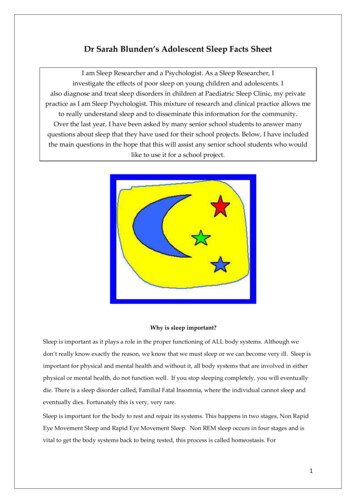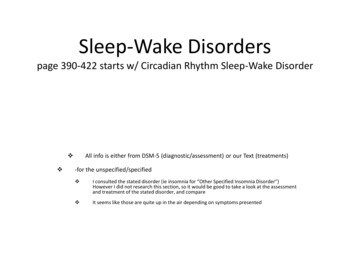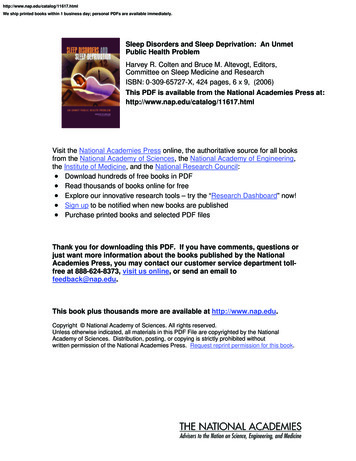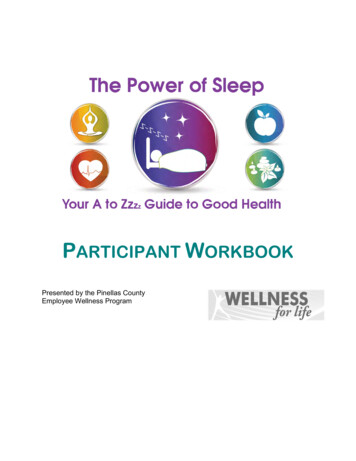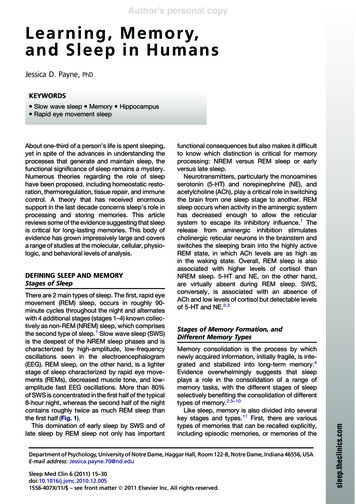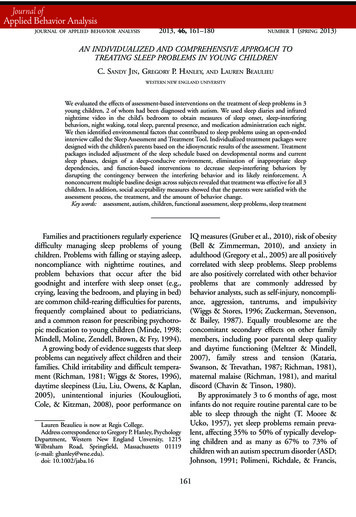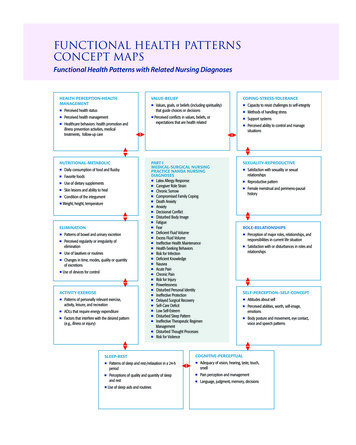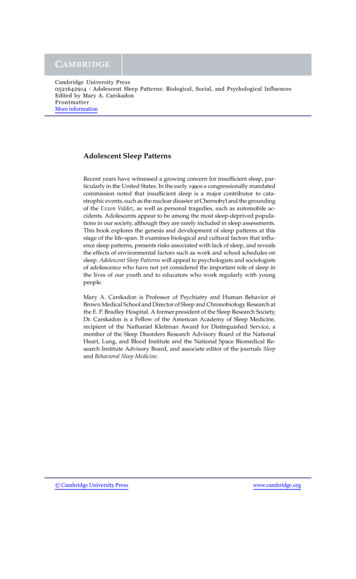
Transcription
Cambridge University Press0521642914 - Adolescent Sleep Patterns: Biological, Social, and Psychological InfluencesEdited by Mary A. CarskadonFrontmatterMore informationAdolescent Sleep PatternsRecent years have witnessed a growing concern for insufficient sleep, particularly in the United States. In the early 1990s a congressionally mandatedcommission noted that insufficient sleep is a major contributor to catastrophic events, such as the nuclear disaster at Chernobyl and the groundingof the Exxon Valdez, as well as personal tragedies, such as automobile accidents. Adolescents appear to be among the most sleep-deprived populations in our society, although they are rarely included in sleep assessments.This book explores the genesis and development of sleep patterns at thisstage of the life-span. It examines biological and cultural factors that influence sleep patterns, presents risks associated with lack of sleep, and revealsthe effects of environmental factors such as work and school schedules onsleep. Adolescent Sleep Patterns will appeal to psychologists and sociologistsof adolescence who have not yet considered the important role of sleep inthe lives of our youth and to educators who work regularly with youngpeople.Mary A. Carskadon is Professor of Psychiatry and Human Behavior atBrown Medical School and Director of Sleep and Chronobiology Research atthe E. P. Bradley Hospital. A former president of the Sleep Research Society,Dr. Carskadon is a Fellow of the American Academy of Sleep Medicine,recipient of the Nathaniel Kleitman Award for Distinguished Service, amember of the Sleep Disorders Research Advisory Board of the NationalHeart, Lung, and Blood Institute and the National Space Biomedical Research Institute Advisory Board, and associate editor of the journals Sleepand Behavioral Sleep Medicine. Cambridge University Presswww.cambridge.org
Cambridge University Press0521642914 - Adolescent Sleep Patterns: Biological, Social, and Psychological InfluencesEdited by Mary A. CarskadonFrontmatterMore informationAdolescent Sleep PatternsBiological, Social, andPsychological InfluencesEdited byMARY A. CARSKADONBrown Medical School Cambridge University Presswww.cambridge.org
Cambridge University Press0521642914 - Adolescent Sleep Patterns: Biological, Social, and Psychological InfluencesEdited by Mary A. CarskadonFrontmatterMore informationpublished by the press syndicate of the university of cambridgeThe Pitt Building, Trumpington Street, Cambridge, United Kingdomcambridge university pressThe Edinburgh Building, Cambridge cb2 2ru, uk40 West 20th Street, New York, ny 10011-4211, usa477 Williamstown Road, Port Melbourne, vic 3207, AustraliaRuiz de Alarcón 13, 28014 Madrid, SpainDock House, The Waterfront, Cape Town 8001, South Africahttp://www.cambridge.org CCambridge University Press 2002This book is in copyright. Subject to statutory exceptionand to the provisions of relevant collective licensing agreements,no reproduction of any part may take place withoutthe written permission of Cambridge University Press.First published 2002Printed in the United Kingdom at the University Press, CambridgeTypeface Palatino 10/13 pt.System LATEX 2ε [TB]A catalog record for this book is available from the British Library.Library of Congress Cataloging in Publication dataAdolescent sleep patterns : biological, social, and psychological influences / edited byMary A. Carskadon.p.cm.Includes bibliographical references and index.isbn 0-521-64291-41. Sleep disorders in children. 2. Health behavior in adolescence. 3. Sleep.I. Carskadon, Mary A.rj506.5.s55 a364616.8 498 – dc2120022001037541isbn 0 521 64291 4 hardback Cambridge University Presswww.cambridge.org
Cambridge University Press0521642914 - Adolescent Sleep Patterns: Biological, Social, and Psychological InfluencesEdited by Mary A. CarskadonFrontmatterMore informationContentsList of Contributorspage viiForewordwilliam c. dementixPrefacemary a. carskadonxiii1 Sleep and Adolescence: A Social Psychologist’sPerspectivesanford m. dornbusch2 Factors Influencing Sleep Patterns of Adolescentsmary a. carskadon143 Endocrine Changes Associated with Pubertyand Adolescencegary s. richardson and barbara a. tate274 Maturational Changes in Sleep-Wake Timing:Longitudinal Studies of the Circadian ActivityRhythm of a Diurnal Rodentbarbara a. tate, gary s. richardson,and mary a. carskadon405 Nutrition and Circadian Activity Offset in AdolescentRhesus Monkeysmari s. golub, peter t. takeuchi,and tana m. hoban-higgins6 Toward a Comparative Developmental Ecologyof Human Sleepcarol m. worthman and melissa k. melby5069v Cambridge University Presswww.cambridge.org
Cambridge University Press0521642914 - Adolescent Sleep Patterns: Biological, Social, and Psychological InfluencesEdited by Mary A. CarskadonFrontmatterMore informationviContents7 Sleep Patterns of High School Students Livingin São Paulo, Brazilmiriam andrade and l. menna-barreto1188 Sleep Patterns and Daytime Function in Adolescence:An Epidemiological Survey of an Italian High SchoolStudent Sampleflavia giannotti and flavia cortesi1329 Risks of Driving While Sleepy in Adolescentsand Young Adultsmary a. carskadon14810 What Can the Study of Work Scheduling Tell Us aboutAdolescent Sleep?roger h. rosa15911 Accommodating the Sleep Patterns of Adolescents withinCurrent Educational Structures: An Uncharted Pathkyla l. wahlstrom17212 Bridging the Gap between Research and Practice:What Will Adolescents’ Sleep-Wake PatternsLook Like in the 21st Century?amy r. wolfson19813 Influence of Irregular Sleep Patterns on Waking Behaviorchristine acebo and mary a. carskadon22014 Stress and Sleep in Adolescence: A Clinical-DevelopmentalPerspectiveavi sadeh and reut gruber23615 The Search for Vulnerability Signatures for Depressionin High-Risk Adolescents: Mechanisms and Significancejames t. m c cracken25416 The Regulation of Sleep-Arousal, Affect, and Attentionin Adolescence: Some Questions and Speculationsronald e. dahl269Index Cambridge University Press285www.cambridge.org
Cambridge University Press0521642914 - Adolescent Sleep Patterns: Biological, Social, and Psychological InfluencesEdited by Mary A. CarskadonFrontmatterMore informationContributorsChristine Acebo, Brown Medical SchoolMiriam Andrade, University of São PauloMary A. Carskadon, Brown Medical SchoolFlavia Cortesi, University “La Sapienza,” RomeRonald E. Dahl, University of PittsburghWilliam C. Dement, Stanford UniversitySanford M. Dornbusch, Stanford UniversityFlavia Giannotti, University “La Sapienza,” RomeMari S. Golub, University of California, DavisReut Gruber, Tel-Aviv UniversityTana M. Hoban-Higgins, University of California, DavisJames T. McCracken, UCLA Neuropsychiatric Hospital, Los AngelesMelissa K. Melby, Emory UniversityL. Menna-Barreto, University of São PauloGary S. Richardson, Henry Ford Hospital, DetroitRoger H. Rosa, U.S. Department of Health and Human Services,CincinnatiAvi Sadeh, Tel-Aviv UniversityPeter T. Takeuchi, University of California, DavisBarbara A. Tate, Children’s Hospital of BostonKyla L. Wahlstrom, University of MinnesotaAmy R. Wolfson, College of the Holy CrossCarol M. Worthman, Emory Universityvii Cambridge University Presswww.cambridge.org
Cambridge University Press0521642914 - Adolescent Sleep Patterns: Biological, Social, and Psychological InfluencesEdited by Mary A. CarskadonFrontmatterMore informationForewordwilliam c. dementAdolescence is the great and terrifying transition from childhood toadulthood. It is in the interest of a civilized society that a mature, responsible, and well-educated young adult emerges from this transition.Along with mental and physical maturation, a triumvirate of preventive health should be inculcated during adolescence as a permanentphilosophy of living. The practice of nutritional health will ensure thebest possible outcome during the process of growing older. Exerciseand physical fitness, likewise, will also foster health and quality of life.Healthy adequate sleep will foster longevity and particularly the optimal use of our waking hours. We are not healthy unless our sleep ishealthy. Sadly (perhaps the raison d’être of this volume), the inculcationof this third member of the triumvirate of preventive health is absent.Furthermore, its absence can have many known and as yet unknowndeleterious effects on human life.A recent report of an exhaustive study on adolescence, Great Transitions: Preparing Adolescents for a New Century prepared by the CarnegieCorporation of New York (1995), exemplifies the puzzling and frustrating blind spot regarding sleep issues by even the best of the best. Whileexcellent, thorough, and future-oriented in every other area, the reportdid not mention adolescent sleep or biological rhythms.It has been my great privilege to be associated for many years withthe editor and progenitor of this book. I knew her first as a family member (a cousin of my wife), and then I was very lucky that a uniqueconcatenation of events brought her to Stanford University in 1970. Shedirected a truly pioneering program on the scientific study of daytimesleepiness in the Stanford University Summer Sleep Camp from 1975to 1985. The studies in this remarkable facility established the scientificbasis of our current understanding of the critical dimension of wakingix Cambridge University Presswww.cambridge.org
Cambridge University Press0521642914 - Adolescent Sleep Patterns: Biological, Social, and Psychological InfluencesEdited by Mary A. CarskadonFrontmatterMore informationxForewordsleepiness-alertness and its nocturnal determinants. In addition, and ofgreat importance to the topic of this book, she directed a longitudinalstudy of a cohort of children as they went through the great transitionof adolescence.At the beginning of this remarkable decade of research, the gold standard of assessing daytime sleepiness, the multiple sleep latency test(MSLT), was developed and applied. Using this test each summer on thelongitudinal cohort, it was established that sleep need does not changeor may even increase during the great transition. The MSLT also allowedan assessment of the effect of sleep restriction on daytime alertness; forthe first time, it was clear that the impact of lost sleep accumulates fromday to day. This accumulation is often referred to as the “sleep debt.”Finally, the great disparity between MSLT measures of sleep need inadolescents versus questionnaire data on actual sleep obtained at homeduring the school year allows us to conclude that many, if not most,adolescents must be severely, chronically sleep deprived. The data basesare very small, but students falling asleep in class are a familiar sightto middle school and, particularly, high school teachers. This situationis further complicated by the biological tendency for phase delay ofcircadian rhythms and the markedly increased prevalence of studentsholding extracurricular jobs, usually in the evening, to earn money.During much of 1990 and 1991, Dr. Carskadon and I served on theNational Commission on Sleep Disorders Research, which carried outa congressionally mandated study of the role of sleep deprivation andsleep disorders in American society. One of the areas that we examinedwas whether the facts about sleep that we have known for more thantwo decades have actually been integrated into the educational systemand the health care system. Unfortunately, crucial education about sleepneed and biological rhythms and sleep disorders likely to occur in adolescence was completely absent. It is my very strong opinion that allhuman beings become victims of the lack of awareness about sleep during the great transition and, to some extent, for the rest of their lives.Although data on sleep disorders in latency-age children are limited,the studies conducted by Dr. Carskadon, particularly for children inmiddle- and upper-class environments, suggest that sleep needs aregenerally fulfilled at this age with a resulting optimal daytime alertnessand performance.In terms of developing a society in which healthy sleep is a priority,the optimal target may be the developing adolescent. Crucial materialabout sleep, sleep deprivation, biological rhythms, and sleep disorders Cambridge University Presswww.cambridge.org
Cambridge University Press0521642914 - Adolescent Sleep Patterns: Biological, Social, and Psychological InfluencesEdited by Mary A. CarskadonFrontmatterMore informationForewordxican be readily taught at this age level. It might also be possible to introduce effective interventions to promote positive schedule strategiesthat allow more time for sleep. For example, a great deal can be accomplished by using the “bully pulpit” of driver training, a key issue for alladolescents.Another area pioneered by Dr. Carskadon and to some extent revealed during the early days of the Stanford University Sleep Disorderclinic is what is now called the delayed sleep phase syndrome. In theStanford studies and more recently in her research at Brown and in thework of others, it has become clear that there is a major biological rhythmproblem in adolescence, and this problem clearly exacerbates the sleeploss problem. This knowledge has come onto the radar screen in recentyears with sporadically successful efforts to change the starting time inhigh schools to a later hour. Accomplishing this initiative is uniquelydifficult because of the complexity of forces determining the schoolschedule. Preliminary data where the starting time has been successfullydelayed have been promising.Finally, it is time to address the pervasive adolescent problem ofschool schedule–biological clock mismatch in some effective manner.There is an urgent need for researchers and clinicians in the area covered by this volume to cooperate, to arrive at a consensus, and to provideleadership both in adding to the necessary scientific data bases to fosterchange, and to provide leadership in advocating wise public policy inthis crucial area. Leadership is needed at every level, including localschool boards, county and state organizations, and even at the federallevel. Dr. Carskadon is certainly the outstanding leader in this area, andshe has assembled a tiny band of other leading researchers to producea very important and long-overdue book. Cambridge University Presswww.cambridge.org
Cambridge University Press0521642914 - Adolescent Sleep Patterns: Biological, Social, and Psychological InfluencesEdited by Mary A. CarskadonFrontmatterMore informationPrefacemary a. carskadonThe maturation of sleep patterns in teens has been a focus of my researchfor 25 years – long enough for the teens I first studied to have teenagersof their own. I often wonder why we don’t know it all yet, and then Istep into the world and am reminded of the complexity of life and theaccelerating rate of change in opportunities, expectations, technology,and social mores. Developing humans are at the center of it all, withsleep’s core behavioral role at the mercy of these factors and many more.I am humbled by the task of attempting to understand the phenomena we observe, and I am inspired by the process of scientific investigation. As in other fields, progress is usually neither linear nor direct; it is affected by the evolution of methodologies and ideas, andthe flow of knowledge can be entirely redirected by conceptual breakthroughs. My research in the area of adolescent sleep patterns has benefited from several such major reconstructive conceptual shifts. Thefirst seism occurred in the longitudinal Summer Sleep Camp studyat Stanford – inspired by William Dement and Thomas Anders – inwhich we not only failed to confirm the predicted reduction of sleepneed across adolescent development but also showed a restructuringof sleep so that pubertal adolescents sleeping no less than before wereactually sleepier in the afternoon. The conclusion: teens don’t need lesssleep.A second movement of our conceptual tectonic plates fractured theassumption that the delay in the timing of sleep in adolescents, especiallylater bedtimes, was purely a psychosocial phenomenon. Instead, wenow find that the brain’s mechanisms controlling the timing of sleepappear to undergo a shift at adolescence that is permissive of and in somemay drive the teen phase delay. The conclusion: teens cannot simplydecide to fall asleep or wake up.xiii Cambridge University Presswww.cambridge.org
Cambridge University Press0521642914 - Adolescent Sleep Patterns: Biological, Social, and Psychological InfluencesEdited by Mary A. CarskadonFrontmatterMore informationxivPrefaceThe major theoretical contribution that allows us to frame a biologicalcontext for these investigations began with A. A. Borbély’s articulationof the two-process model of sleep (in Human Neurobiology, 1982), a modelthat allows us to predict and examine the principal biological components regulating sleep. Combined with new methods and measures, thetheoretical advances in understanding these biological factors provideexciting opportunities. The story of adolescent sleep goes beyond biology, however, and the contributors to this book provide stepping-stonesleading to the future development of this ever challenging area of study.The birthplace of this project was an international symposium onContemporary Perspectives on Adolescent Sleep held in Marina delRey, California, in April 1997. The symposium was sponsored by theUniversity of California at Los Angeles, Youth Enhancement Services(YES), under the leadership of Michael Chase, Ph.D., and supported byan unrestricted educational grant from the Anheuser-Busch Foundation.Many of the attendees at the symposium have authored chapters in thisbook. We are indebted to Dr. Chase and the Anheuser-Busch Foundationfor assembling us to begin this project.I can never thank Bill Dement, M.D., Ph.D., adequately for all of hisenthusiastic support and encouragement over many years of mentorship. I am again indebted to him for writing the Foreword to this bookand providing such a persuasive reminder of the importance of thiswork in his usual charismatic style.One clear gap in understanding the place of sleep in the lives of teenshas been its integration with social roles and societal forces that influence teens. I am grateful to Dr. Sanford Dornbusch for his chapter, whichdiscloses so eloquently the blind eye that the field of adolescent sociology has turned toward sleep and acknowledges the likely importancethe assessment of sleep may hold for sociologists.I tried to provide some scaffolding for subsequent chapters in abroad overview of “Factors Influencing Sleep Patterns of Adolescents,”Chapter 2. An outline of issues from home, to work, to school, to basicbiological concepts precedes the description of our field-lab study in 9thand 10th grade students. This particular study clarifies most strongly forme the enormous burden an early school start time places on adolescentsgiven no support to make appropriate adjustments.The overview of “Endocrine Changes Associated with Puberty andAdolescence” by Gary Richardson and Barbara Tate adds to the scaffold with a clear explanation of human neuroendocrine system changes during this critical developmental phase and how these changes Cambridge University Presswww.cambridge.org
Cambridge University Press0521642914 - Adolescent Sleep Patterns: Biological, Social, and Psychological InfluencesEdited by Mary A. CarskadonFrontmatterMore informationPrefacexvinfluence brain mechanisms that contribute to the control of sleep andwakefulness.The idea for chapters on comparative biology of adolescent sleeppatterns was inspired by an e-mail from Mari Golub in 1996 asking meto help interpret activity pattern findings from her adolescent Rhesusmonkeys. I was working at the time with Barbara Tate to develop arodent model (Octodon degus) to examine similar issues. The explorationsof adolescent activity patterns in these species in Chapters 4 and 5 offerinteresting counterpoints to the human condition and add strength tothe hypothesis that biological changes at the adolescent transition assista phase delay.In the course of a research career, certain moments in time hold salientplaces in our intellectual development or scientific yearning. One suchmoment for me came during the challenge of grant writing while collecting data at the Stanford Sleep Camp in the summer of 1979. Thisstriking image includes an overwhelming sense of urgency to knowabout sleep patterns from the viewpoint of an anthropologist: what isthe developmental pattern of sleep in non-Westernized cultures? I remember vividly my desire to know right then and there and my wishthat I could do the field work myself. Of course, this urgency dissipatedin the throes of ongoing work, but the yearning for this knowledge hasremained. Thus, one of my most gratifying experiences was meetingDr. Carol Worthman at the symposium, and I am thrilled to include herscholarly presentation, “Toward a Comparative Developmental Ecologyof Human Sleep,” in this book. Carol’s chapter is the first comprehensiveassessment of human sleep from the perspective of an anthropologist,and it is stunning in its scope and analysis. Worthman and her colleague, Melissa Melby, have embraced this effort with enthusiasm, andI am both grateful for and a bit in awe of their accomplishment. I amalso delighted to know that Carol has recently completed the first fieldstudy specifically to examine sleep, the first of what I hope are many tofollow.Two views of adolescent sleep patterns from disparate contemporary “Westernized” societies are provided in the chapters by MiriamAndrade and Luiz Menna-Barreto, who examine the sleep of teensin São Paolo, and by Flavia Gianotti and Flavia Cortesi, who probesleep patterns and sleep problems of Italian teens. These chapters standin contrast to the anthropological perspective and as introduction tothe issues of sleep patterns and school schedules in North Americanadolescents. Cambridge University Presswww.cambridge.org
Cambridge University Press0521642914 - Adolescent Sleep Patterns: Biological, Social, and Psychological InfluencesEdited by Mary A. CarskadonFrontmatterMore informationxviPrefaceBefore considering these concerns, however, our journey through theworld of adolescent sleep takes two brief side trips to explore relatedbut more tangential issues. I have wanted to summarize the data fromour adolescent driving risk surveys for a number of reasons. First, theyhold an inherent message about drowsy driving in teens. In addition, Ihave wanted to honor the cherished memory of and say farewell to mydear friend, Helen Bearpark, Ph.D., who shared in this research and forwhom the issue of drowsy driving was a compelling concern. Thankyou, Helen. Roger Rosa takes us next to Finland for an examinationof adult workers who experience early-morning shift schedules. Hisresearch points out not only difficulties associated with such work shiftsbut also the challenges of making life-style choices to accommodatesleep under those circumstances. Adolescents with early school starttimes face similar challenges.To my knowledge, Kyla Wahlstrom is the first career educator tohave embraced a research interest at the interface of school schedulesand teen sleep. I marvel at the complexities of school systems that Kyla’schapter charts for us, as she examines step by step the structures thatimpact decisions about the school schedule. The tantalizing tales ofthe Edina, Minnesota, experience only whet our appetites for resultsfrom Kyla’s longitudinal assessments of the Minneapolis “experiment.”A preliminary summary of those findings is included as an appendixto her chapter.Amy Wolfson’s chapter takes aim at the challenges that face teenagersas this century progresses and provides useful suggestions that mayhelp reverse societal, family, and life-style trends providing the pressureto shrink adolescent sleep. This insightful presentation gives us fairwarning and prescriptive recommendations.I find Christine Acebo’s assessment of adolescent sleep patterns in“Influence of Irregular Sleep Patterns on Waking Behavior” very important in its unique examination of sleep’s impact while controllingfor other important factors. This chapter acknowledges that such outcomes as grades, depressed mood, injuries associated with alcohol ordrugs, and absenteeism are multidetermined. The subsequent analytical models then include sleep predictors in multiple regressions thatallow us to identify clearly the significant impact of sleep amount andregularity, even when accounting for age, sex, race, educational expectations, learning disabilities, and substance use. These findings highlightthe crucial role of sleep and provide a strong introduction for the finalchapters. Cambridge University Presswww.cambridge.org
Cambridge University Press0521642914 - Adolescent Sleep Patterns: Biological, Social, and Psychological InfluencesEdited by Mary A. CarskadonFrontmatterMore informationPrefacexviiThe last three chapters of this book provide more clinical perspectives of adolescent sleep patterns. Avi Sadeh and Reut Gruber write ofthe ways stressful events in adolescents’ lives can impinge on sleep. Thecase vignettes concluding their chapter put real faces to the theoreticalmodels and predictions. James McCracken is a practicing psychiatristand researcher who has studied depression in adolescence. He summarizes for the clinical scientist the ways in which adolescents’ sleep anddepressed mood are intertwined and speculates on neural substrates.Ronald Dahl writes compellingly of the challenges an adolescent’s brainfaces to achieve a successful integration of cognitive and emotional development and how this process is impacted by and has an impact onthe sleep patterns of adolescents.I thank all these authors for their thoughtful contributions to thisbook and their patience with the process. I believe we have assembled aset of perspectives that will enlighten and inform. I must also especiallythank Christine Acebo and Amy Wolfson for helping bring this workto fruition and Marian “Max” Elliott for her many hours of labor andsolicitous forbearance of my moods. Cambridge University Presswww.cambridge.org
Cambridge University Press0521642914 - Adolescent Sleep Patterns: Biological, Social, and Psychological InfluencesEdited by Mary A. CarskadonFrontmatterMore informationAdolescent Sleep Patterns Cambridge University Presswww.cambridge.org
gary s. richardson and barbara a. tate 4 Maturational Changes in Sleep-Wake Timing: Longitudinal Studies of the Circadian Activity Rhythm of a Diurnal Rodent 40 barbara a. tate, gary s. richardson, and mary a. carskadon 5 Nutrition and Circadian Activity Offset in Adolescent Rhesus Monkeys 50 mari s. golub, peter t. takeuchi, and tana m. hoban .
